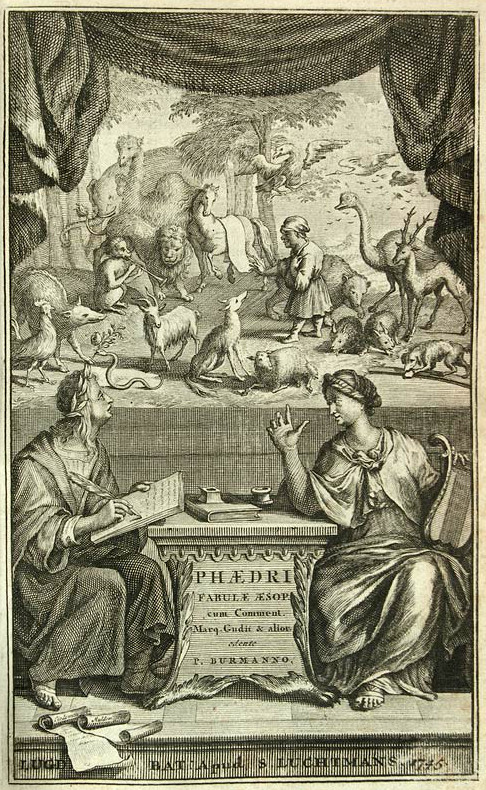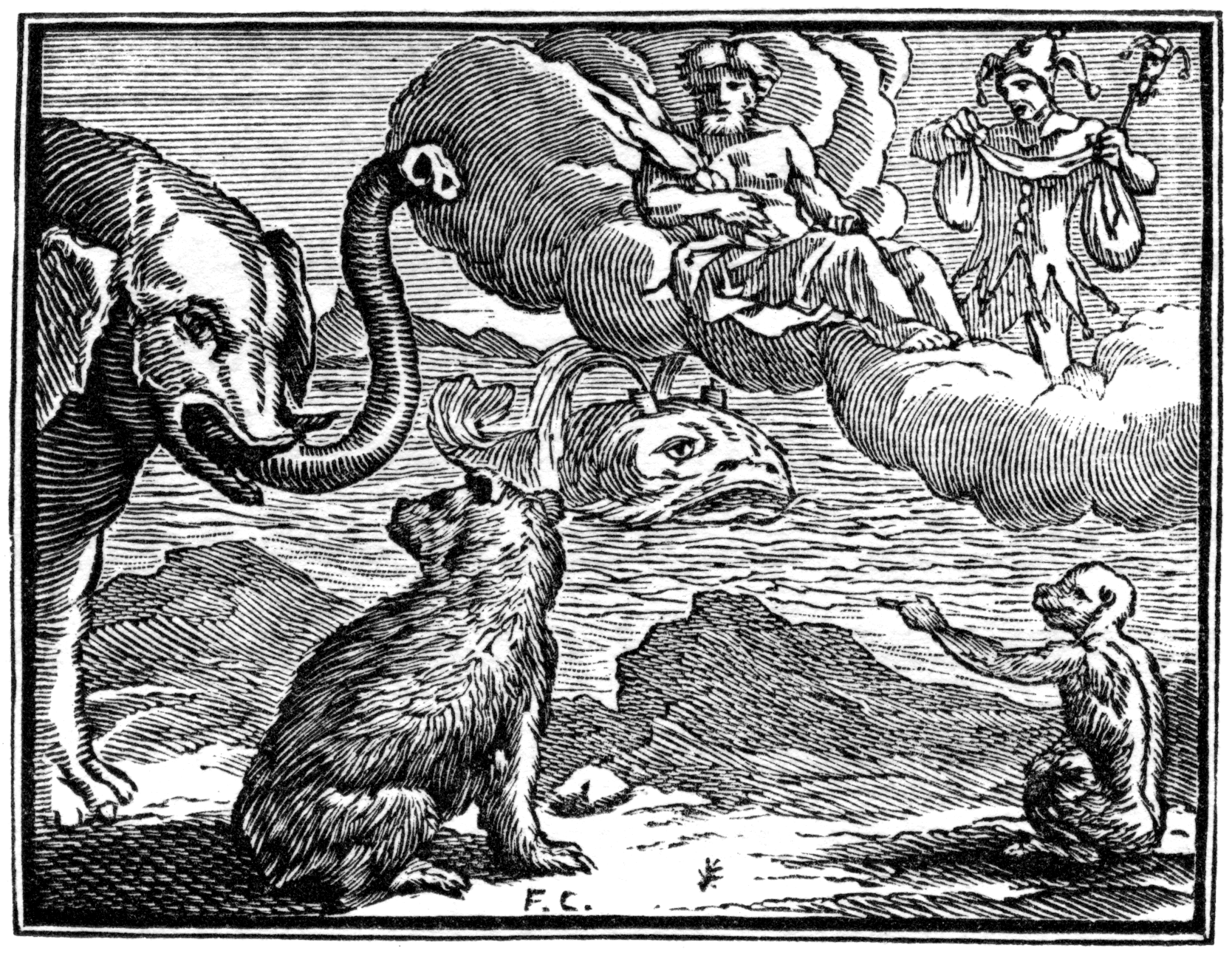|
The Cat And The Mice
The Cat and the Mice is a fable attributed to Aesop's Fables, Aesop of which there are several variants. Sometimes a weasel is the predator; the prey can also be rats and chickens. The Fables The Greek version of the fable recorded by Babrius concerns a cat that pretends to be a sack hanging from a peg in order to deceive the chickens, but his disguise is seen through by a rooster. This is numbered 79 in the Perry Index. William Caxton tells a very much amplified story of the rats that are the cat's victims. These hold a council and make the decision to stay off the floor and keep in the rafters. The cat then hangs himself from a hook and pretends to be dead, but the rats are not deceived. Later authors substituted mice for rats. The moral lesson taught by these stories is summed up by the English proverb 'Once bitten, twice shy'. The episode of the rats holding a council is similar to the fable of The Mice in Council who suggested hanging a bell on the cat, but that only developed ... [...More Info...] [...Related Items...] OR: [Wikipedia] [Google] [Baidu] |
Fable
Fable is a literary genre: a succinct fictional story, in prose or verse, that features animals, legendary creatures, plants, inanimate objects, or forces of nature that are anthropomorphized, and that illustrates or leads to a particular moral lesson (a "moral"), which may at the end be added explicitly as a concise maxim or saying. A fable differs from a parable in that the latter ''excludes'' animals, plants, inanimate objects, and forces of nature as actors that assume speech or other powers of humankind. Conversely, an animal tale specifically includes talking animals as characters. Usage has not always been so clearly distinguished. In the King James Version of the New Testament, "" ("''mythos''") was rendered by the translators as "fable" in the First Epistle to Timothy, the Second Epistle to Timothy, the Epistle to Titus and the First Epistle of Peter. A person who writes fables is a fabulist. History The fable is one of the most enduring forms of folk literat ... [...More Info...] [...Related Items...] OR: [Wikipedia] [Google] [Baidu] |
Aesop's Fables
Aesop's Fables, or the Aesopica, is a collection of fables credited to Aesop, a slave and storyteller believed to have lived in ancient Greece between 620 and 564 BCE. Of diverse origins, the stories associated with his name have descended to modern times through a number of sources and continue to be reinterpreted in different verbal registers and in popular as well as artistic media. The fables originally belonged to oral tradition and were not collected for some three centuries after Aesop's death. By that time, a variety of other stories, jokes and proverbs were being ascribed to him, although some of that material was from sources earlier than him or came from beyond the Greek cultural sphere. The process of inclusion has continued until the present, with some of the fables unrecorded before the Late Middle Ages and others arriving from outside Europe. The process is continuous and new stories are still being added to the Aesop corpus, even when they are demonstrably more ... [...More Info...] [...Related Items...] OR: [Wikipedia] [Google] [Baidu] |
Babrius
Babrius ( grc-gre, Βάβριος, ''Bábrios''; century),"Babrius" in ''Chambers's Encyclopædia''. London: George Newnes, 1961, Vol. 2, p. 21. also known as Babrias () or Gabrias (), was the author of a collection of Greek fables, many of which are known today as Aesop's Fables. Life Practically nothing is known of him. He is supposed to have been a Hellenized Roman, whose original name may have been Valerius. He lived in the East, probably in Syria, where the fables seem first to have gained popularity. The address to "a son of King Alexander" has caused much speculation, with the result that dates varying between the 3rd century BC and the 3rd century AD have been assigned to Babrius. The Alexander referred to may have been Alexander Severus (AD 222–235), who was fond of having literary men of all kinds about his court. "The son of Alexander" has further been identified with a certain Branchus mentioned in the fables, and it is suggested that Babrius may have been his tutor; ... [...More Info...] [...Related Items...] OR: [Wikipedia] [Google] [Baidu] |
Perry Index
The Perry Index is a widely used index of "Aesop's Fables" or "Aesopica", the fables credited to Aesop, the storyteller who lived in ancient Greece between 620 and 560 BC. The index was created by Ben Edwin Perry, a professor of classics at the University of Illinois Urbana-Champaign. Modern scholarship takes the view that Aesop probably did not compose all of the fables attributed to him;D. L. Ashliman, “Introduction,” in George Stade (Consulting Editorial Director), ''Aesop’s Fables.'' New York: Barnes & Noble Classics, (2005). Produced and published in conjunction with Fine Creative Media, Inc. (New York) Michael J. Fine, President and Publisher. See pp. xiii–xv and xxv–xxvi. indeed, a few are known to have first been used before Aesop lived, while the first record we have of many others is from well over a millennium after his time. Traditionally, Aesop's fables were arranged alphabetically, which is not helpful to the reader. Perry listed them by language (Greek ... [...More Info...] [...Related Items...] OR: [Wikipedia] [Google] [Baidu] |
William Caxton
William Caxton ( – ) was an English merchant, diplomat and writer. He is thought to be the first person to introduce a printing press into England, in 1476, and as a printer (publisher), printer to be the first English retailer of printed books. His parentage and date of birth are not known for certain, but he may have been born between 1415 and 1424, perhaps in the Weald or wood land of Kent, perhaps in Hadlow or Tenterden. In 1438 he was apprenticed to Robert Large, a wealthy London silk Mercery, mercer. Shortly after Large's death, Caxton moved to Bruges, Belgium, a wealthy cultured city in which he was settled by 1450. Successful in business, he became governor of the Company of Merchant Adventurers of London; on his business travels, he observed the new printing industry in Cologne, which led him to start a printing press in Bruges in collaboration with Colard Mansion. When Margaret of York, sister of Edward IV, married the Charles the Bold, Duke of Burgundy, they moved ... [...More Info...] [...Related Items...] OR: [Wikipedia] [Google] [Baidu] |
Phaedrus (fabulist)
Gaius Julius Phaedrus (; grc-gre, Φαῖδρος; Phaîdros) was a 1st-century CE Roman Empire, Roman fabulist and the first versifier of a collection of Aesop's fables into Latin. Few facts are known about him for certain and there was little mention of his work during late antiquity. It was not until the discovery of a few imperfect manuscripts during and following the Renaissance that his importance emerged, both as an author and in the transmission of the fables. Biography A recent statement of the few facts that past scholars have tried to deduce from autobiographical hints given by Phaedrus in his poems has summarised them as follows: He was born in Macedonia, probably in Pydna, about 15 BCE, came to Rome as a slave and was freed by Augustus. He probably had some teaching function between then and the time of Tiberius, under whom the first book of his poems appeared. Envious competitors interpreted the morals of some fables as being critical of the regime and he was trie ... [...More Info...] [...Related Items...] OR: [Wikipedia] [Google] [Baidu] |
Roger L'Estrange
Sir Roger L'Estrange (17 December 1616 – 11 December 1704) was an English pamphleteer, author, courtier, and press censor. Throughout his life L'Estrange was frequently mired in controversy and acted as a staunch ideological defender of King Charles II's regime during the Restoration era. His works played a key role in the emergence of a distinct 'Tory' bloc during the Exclusion Crisis of 1679-81. Perhaps his best known polemical pamphlet was ''An Account of the Growth of Knavery'', which ruthlessly attacked the parliamentary opposition to Charles II and his successor James, Duke of York (later King James II), placing them as fanatics who misused contemporary popular anti-Catholic sentiment to attack the Restoration court and the existing social order in order to pursue their own political ends. Following the Exclusion Crisis and the failure of the nascent Whig faction to disinherit James, Duke of York in favour of Charles II's illegitimate son James, 1st Duke of Monmouth ... [...More Info...] [...Related Items...] OR: [Wikipedia] [Google] [Baidu] |
La Fontaine's Fables
Jean de La Fontaine collected fables from a wide variety of sources, both Western and Eastern, and adapted them into French free verse. They were issued under the general title of Fables in several volumes from 1668 to 1694 and are considered classics of French literature. Humorous, nuanced and ironical, they were originally aimed at adults but then entered the educational system and were required learning for school children. Composition history Divided into 12 books, there are 239 of the ''Fables'', varying in length from a few lines to some hundred, those written later being as a rule longer than those written earlier. The first collection of ''Fables Choisies'' had appeared March 31, 1668, dividing 124 fables into six books over its two volumes. They were dedicated to ''"Monseigneur"'' Louis, ''le Grand Dauphin'', the six-year-old son of Louis XIV of France and his queen consort Maria Theresa of Spain. By this time, La Fontaine was 47 and known to readers chiefly as the aut ... [...More Info...] [...Related Items...] OR: [Wikipedia] [Google] [Baidu] |
Cats In Literature
The cat (''Felis catus'') is a Domestication of the cat, domestic species of small carnivorous mammal. It is the only domesticated species in the family Felidae and is commonly referred to as the domestic cat or house cat to distinguish it from the wild members of the family. Cats are commonly kept as house pets but can also be farm cats or feral cats; the feral cat ranges freely and avoids human contact. Domestic cats are valued by humans for companionship and their ability to kill rodents. About 60 cat breeds are recognized by various cat registries. The cat is similar in Cat anatomy, anatomy to the other felid species: they have a strong flexible body, quick reflexes, sharp teeth, and retractable claws adapted to killing small prey. Their night vision and sense of smell are well developed. Cat communication includes Animal communication, vocalizations like meowing, purring, trilling, hissing, growling, and grunting as well as Cat body language, cat-specific body language. ... [...More Info...] [...Related Items...] OR: [Wikipedia] [Google] [Baidu] |
Mice And Rats In Literature
A mouse ( : mice) is a small rodent. Characteristically, mice are known to have a pointed snout, small rounded ears, a body-length scaly tail, and a high breeding rate. The best known mouse species is the common house mouse (''Mus musculus''). Mice are also popular as pets. In some places, certain kinds of field mice are locally common. They are known to invade homes for food and shelter. Mice are typically distinguished from rats by their size. Generally, when a muroid rodent is discovered, its common name includes the term ''mouse'' if it is smaller, or ''rat'' if it is larger. The common terms ''rat'' and ''mouse'' are not taxonomically specific. Typical mice are classified in the genus '' Mus'', but the term ''mouse'' is not confined to members of ''Mus'' and can also apply to species from other genera such as the deer mouse, ''Peromyscus''. Domestic mice sold as pets often differ substantially in size from the common house mouse. This is attributable to breeding and ... [...More Info...] [...Related Items...] OR: [Wikipedia] [Google] [Baidu] |


_-_Foto_G._Dall'Orto_5_ago_2006.jpg)






